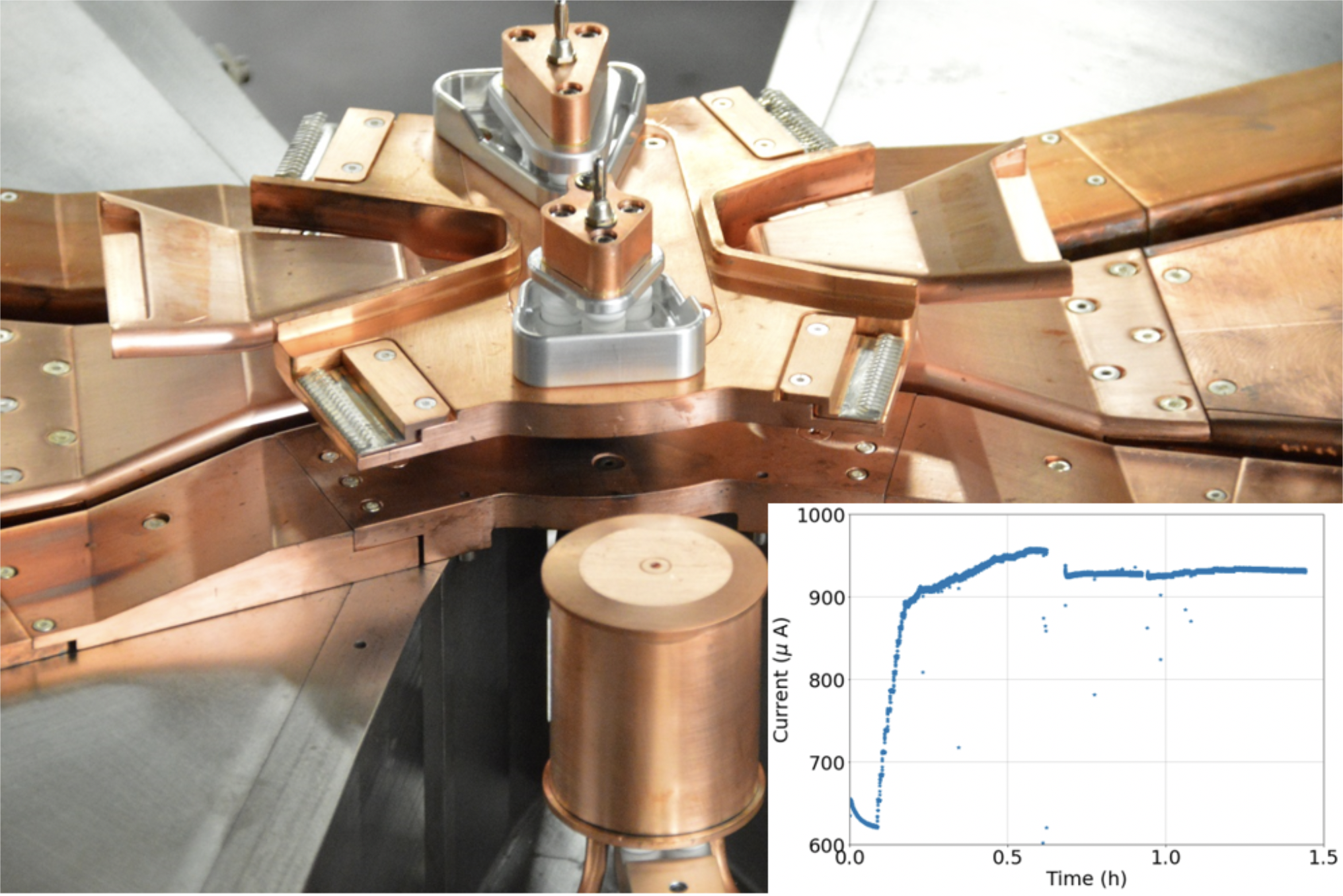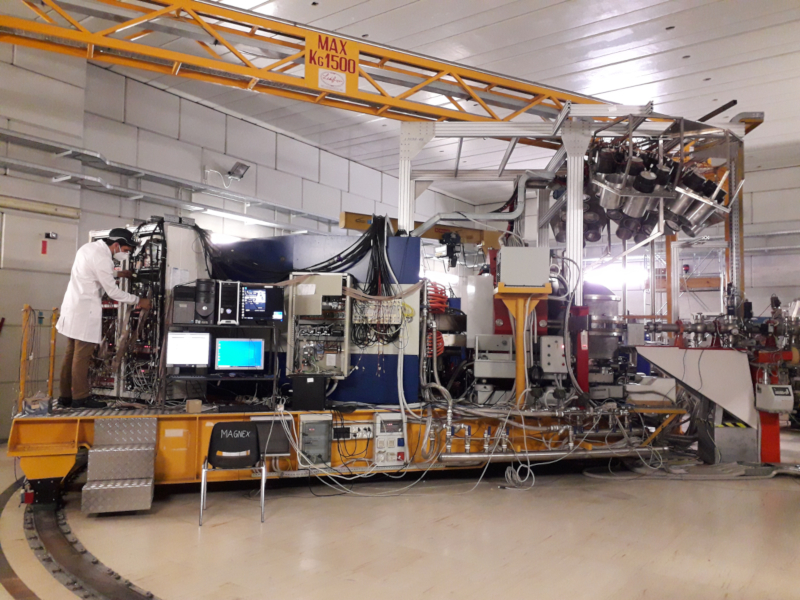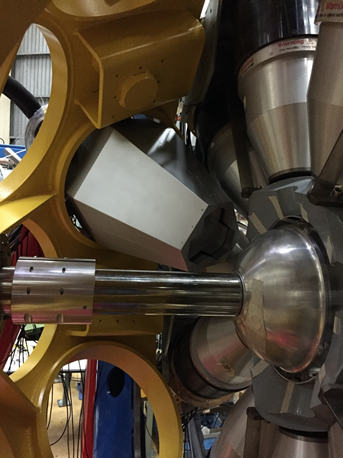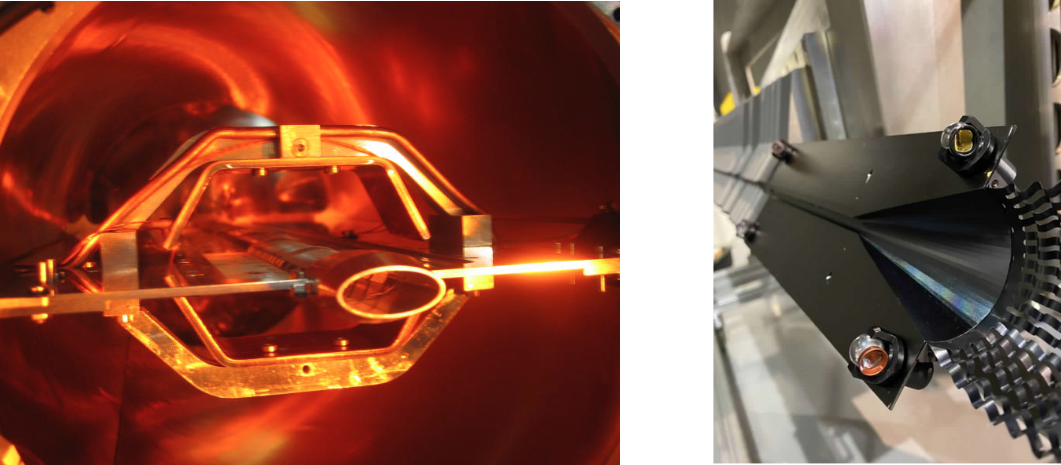Past news
SPES cyclotron in operation
SPES cyclotron in operation
After break for Covid2019 emergency, the LNL team forced the schedule for restarting the Cyclotron operation at 1 MeV energy.
After two years of shutdown for maintenance and to carry on the SPES facility installations, the 70MeV Cyclotron is back in operation. For the first phase it is foreseen to accelerate the beam (H-) up to the energy of 1 MeV to check the well working of the whole system. The radial probe intercepting the beam after few turns was blocked into the cyclotron to not permit the particles to be over accelerated (see figure 1). In the meantime, tests to check the performance limits of the accelerator have been done, and the Cyclotron group got the average current of 950 µA accelerating to 1 MeV with stable behavior over more than one hour (see fig. 1).
This is a breakthrough goal which will permit in the future, by employing a new buncher in the injection line, to achieve more than 1 mA beam accelerated. It will allow to study the current limits of the compact cyclotron accelerator devoted to deliver high power beams.

Fig.1: Central region of SPES cyclotron operational at LNL with the beam stopper in the foreground (copper cylinder shape) intercepting the beam at 1 MeV. In the right box, it is shown the average current trend accelerated into the LNL Cyclotron at 1 MeV energy
NUMEN: the first post-COVID data kick-off the upgrade
NUMEN: the first post-COVID data kick-off the upgrade
NUMEN, the nuclear physics experiment that could help to reveal the Majorana neutrino mystery, successful ends its Phase 2, after the COVID-19 lockdown period. The Phase 2 of the NUMEN (NUclear Matrix Elements for Neutrinoless double beta decay) project has successfully ended. NUMEN Phase 2 aims, among other objectives, to carry out experimental activity with beams accelerated by the Superconducting Cyclotron (CS) of Laboratori Nazionali del Sud (LNS) and the use of the MAGNEX magnetic spectrometer. This experimental activity was carried out and supported within the H2020 ERC project NURE. Since 2014, several measurements have been performed in which the double charge exchange reactions on different candidate isotopes for neutrinoless double beta decay have been studied. These nuclear reactions are closely related to the double beta decay transitions and it has been shown that crucial information can be obtained from them for the determination of the involved nuclear matrix elements.
The conclusion of Phase 2 of NUMEN coincided with the delivery of the last beam accelerated by the CS accelerator in the present configuration at LNS. The upgrade the LNS CS research infrastructures, proposed by the physical case of NUMEN and foreseen in the POT-LNS project, will provide ion beams at intensities higher more than two orders of magnitude higher than to the current ones.
The NUMEN collaboration is now moving towards Phase 3, in which the intense activity of analysis and interpretation of the numerous data collected will be accompanied by the construction of new and more performing detectors, capable of sustaining the high rate expected after the upgrade works.
NUMEN ends a phase and is ready to start a new one!

MAGNEX magnetic spectrometer at Laboratori Nazionali del Sud
Installation of the first triple cluster detector of GALILEO
Installation of the first triple cluster detector of GALILEO
During the week of the 27th of July, the first triple cluster detector of GALILEO was mounted with its anti-Compton shield in the array. The detector is composed of three Germanium hyper-pure crystals installed inside a single cryostat specially developed for GALILEO. The installation of other detectors is scheduled for autumn 2020 and will finally allow to double the detection efficiency of the gamma-ray spectrometer. During the summer, the first tests of the digital electronics will be performed, special attention will be given to the energy resolution, timing and their stability in order to validate the new GALILEO triple cluster and be ready for the physics campaign in autumn.

First triple cluster detector of GALILEO in the experimental hall II of the Tandem-ALPI-PIAVE accelerator complex of LNL.
A storage cell for LHC
Over the past 20 years, the INFN Section of Ferrara has developed a solid and acknowledged experience in the design and construction of storage cells for gaseous targets. The use of this technology has had a significant impact in the field of experimental hadronic physics. Examples of the application of this technology are the target of the HERMES experiment at HERA (DESY), operated from 1995 to 2007, that of the OLYMPUS experiment at DORIS (DESY), operated in the period 2012-2013, and that of the PAX/JEDI experiment, currently in operation at COSY (Forschungszentrum Julich). The storage cell, typically made of a 50-200 mm thick layer of aluminum with cylindrical geometry, is placed inside the beam-pipe of the accelerator, coaxially with the beam. The latter then intercepts directly the target gas contained into the cell, without interacting with other materials, as in the case of solid targets. Furthermore, with respect to the more traditional gaseous jet targets, the use of a storage cell allows to reach areal densities of the order of 1013-1014 atoms/cm2, i.e. up to two orders of magnitude higher. The experience acquired by the Ferrara Section in the framework of CSN3 experiments, has recently allowed to develop a storage cell for the LHCb experiment (SMOG2 project). Starting from RUN3 (2021), LHCb will therefore be the only LHC experiment to be provided with two distinct interaction points and the possibility of operating simultaneously in two collision modes: collider and fixed-target mode. The beam-gas collisions will occur at a center-of-mass energy of 115 GeV for proton beams and 72 GeV for lead beams. SMOG2 will allow to carry out precision studies in the field of QCD and astroparticle physics in essentially unexplored kinematic regions.
Find more details in: http://w3.lnf.infn.it/un-bersaglio-fisso-per-lhc/.

Left: The HERMES storage cell. Right: Half of the LHCb storage cell.
ALICE studies the quark-gluon plasma expansion with charm quarks

ALICE studies the quark-gluon plasma expansion with charm quarks
Charm quarks serve as probes of the quark-gluon plasma (QGP) formed when lead nuclei collide in the LHC. When lead nuclei do not collide head on, the QGP system is elongated and the expansion leads to a dominant elliptical modulation - elliptic flow v2 - in the momentum distribution of hadrons.
The ALICE Collaboration recently measured, using the large lead-lead sample collected in 2018, the elliptic flow of hadrons containing charm quarks, either bound to a light quark (D meson) or in charm-anticharm pairs (J/ψ). The results are shown in the figure as a function of transverse momentum pT. At low momentum, the elliptic flow of D mesons is not as large as that of pions (that contain only light quarks), while the elliptic flow of J/ψ is lower than both, but distinctly observed. This pattern indicates that the heavy charm quarks are dragged with the QGP expansion, but likely to a lesser extent than light quarks, and that both D mesons and J/ψ at low momentum are in part formed by the binding (recombination) of flowing quarks.
The INFN groups played a central role for achievement of these results.
CERN Media Update:
https://home.cern/news/news/physics/cern-collaborations-present-new-results-particles-charm-quarks
Further reading:
D meson anisotropy in Pb-Pb collisions:
https://arxiv.org/pdf/2005.11131.pdf
J/ψ meson anisotropy in Pb-Pb collisions: